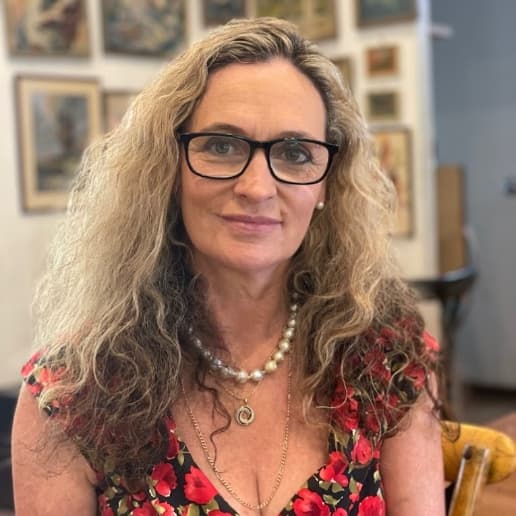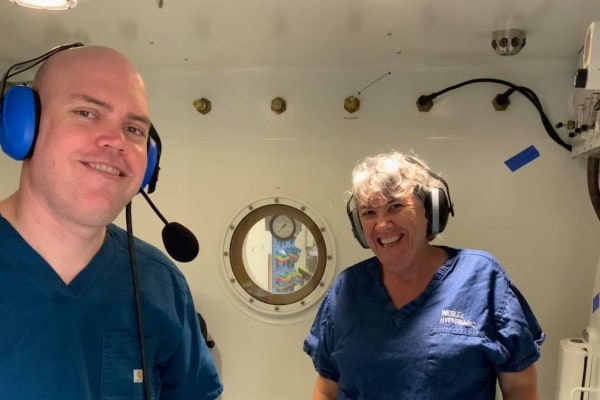Hyperbaric chamber for wound healing

Wounds need oxygen to heal properly. Discover how hyperbaric oxygen therapy may speed up the wound-healing process.
Hyperbaric chamber for non-healing wounds
Why some wounds won’t heal
Time heals all wounds – it’s a popular saying, but not necessarily a true one. Some chronic wounds linger for months and don’t heal without medical intervention.
If a wound hasn’t healed significantly in 30 days, it’s considered a chronic wound. There are many reasons for wounds not to heal properly.
- Infection: Infection may occur when bacteria enter your body through an open wound.
- Poor circulation: During the normal wound-healing process, your body’s red blood cells carry new cells to the wound site and begin rebuilding tissue. Poor circulation slows down this process.
- Diabetes: High blood sugar levels slow down blood circulation.
- Repetitive pressure: If there is too much pressure on the wound, the blood circulation slows down.
- Excessive swelling: Excessive swelling is caused by fluid accumulating in the skin. This can impair the body’s ability to heal a wound by restricting oxygen to the skin.
- Radiation wounds.

Oxygen fuels our cells and helps provide the basic building blocks that our bodies need to survive. When tissue is injured, we need even more oxygen to survive.
The air we breathe in normal circumstances contains 21% oxygen. With hyperbaric oxygen therapy (HBOT) you breathe in 100% oxygen. This helps increase the amount of oxygen your blood can carry. Breathing in pure oxygen at air pressure levels that are 2 to 2.8 times higher than in normal life, causes large amounts of oxygen to be diffused from the plasma into tissues, cells, organs, brain cells, and bones.
HBOT wound healing
Hyperbaric oxygen therapy for non-healing wounds
While it may sound new, hyperbaric oxygen therapy for non-healing wounds is a centuries-old technology. It has been fine-tuned over time to produce the incredible treatment option we have available to us today.

Hyperbaric wound care offers a low-risk medical therapy for non-healing wounds and other conditions that don’t respond well to standard treatments. Using pure oxygen at pressures above regular atmospheric pressure, HBOT nourishes wounds with 100% oxygen.
The extra oxygen in your body supports new blood vessel formation, and improves natural infection control.
The beneficial effects of hyperbaric oxygen in non-healing wounds are:
- Decreases swelling
- Promotes tissue regeneration
- Increases antibacterial activity
- Increases the formation of new blood vessels (angiogenesis)
- Potentiates the action of some antibiotics
- Activates the growth factors in blood platelets
Check our overview page and find out how HBOT can improve your quality of life and overall health.
Skin graft healing
Hyperbaric oxygen therapy for compromised skin grafts and flaps


Skin grafts and flaps are often used in plastic surgery to cover large wounds. The surgeon removes skin from one area of the body and transplants it to another. Hyperbaric oxygen therapy can help grafts and flaps heal when they are not getting enough blood flow or oxygen and have become compromised.
Oxygen fuels our cells and helps provide the basic building blocks that our bodies need to survive. When tissue is injured, we need even more oxygen to survive.
Hyperbaric oxygen therapy can help heal these compromised skin grafts or flaps by bringing more oxygen to the area. Extra oxygen helps your body build new blood vessels, heal damaged tissue, and fight infection.
Hyperbaric chamber for infection
Hyperbaric oxygen therapy for necrotic wounds
When blood and oxygen are limited to a specific area of the body, the tissue often dies (necrosis). When that happens, DNA structure damage occurs within the cells, preventing mitosis – the process of healthy and normal cell duplication. It is necessary for necrotic tissue to be removed to allow wound healing to occur. This is called debridement.

Necrotic tissue can harbour pathogenic bacteria which can lead to infection if left unchecked.
That’s why the doctors and nurses at our Advanced Wound Clinic will remove the dead tissue first as this is necessary before proper healing can begin. Our wound care experts are trained in debridement. Once removed, advanced wound care treatments such as HBOT may be prescribed to continue the healing process for your road to recovery.
Your journey starts with these 3 steps
When you have completed your hyperbaric sessions, your condition is reassessed by one of our doctors.